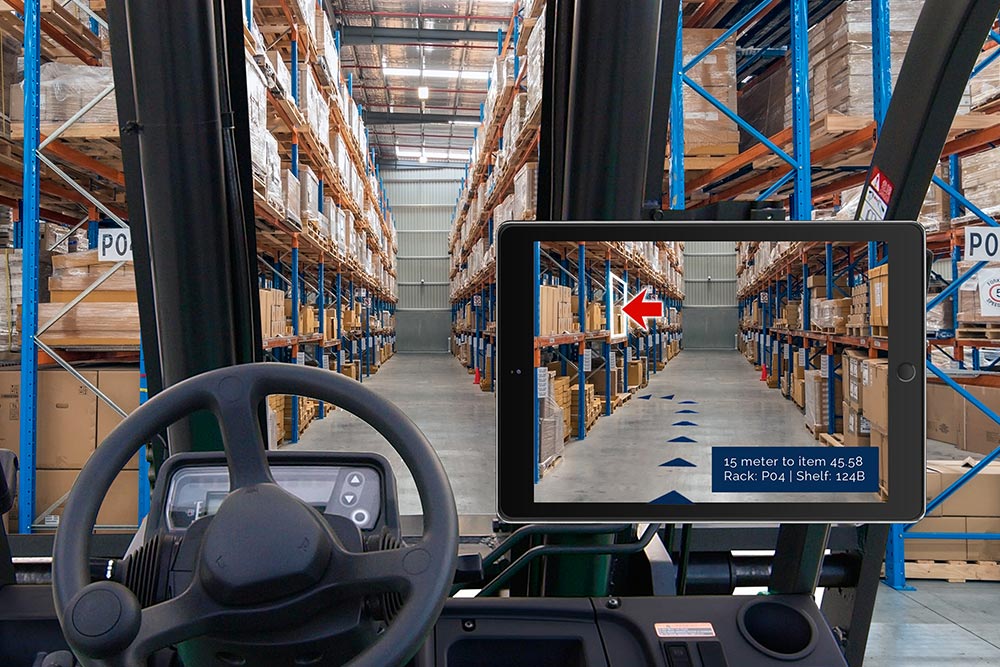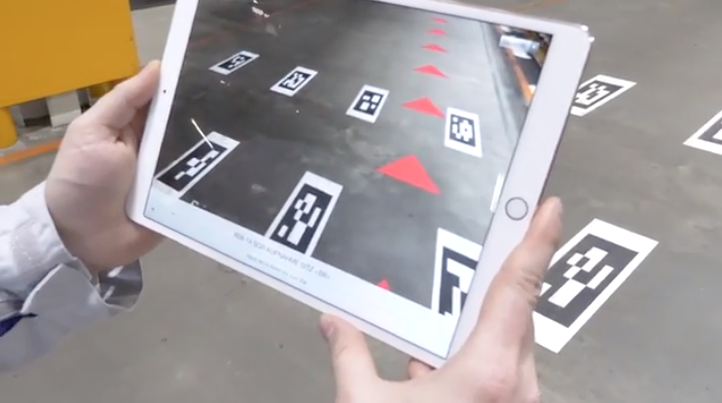In outdoor environments, we all rely on navigation systems to get from one spot to another. GPS is one of the most commonly used technologies for outdoor navigation.
But in indoor environments, wayfinding is a different story. Indoors, GPS doesn’t provide accurate location information, as the signal from GPS satellites that calculate your position is blocked by buildings and walls. It also does not provide 3-dimensional navigation capabilities.
As there is a huge demand for indoor navigation solutions as a part of Industry 4.0 technologies, we need other solutions for wayfinding in buildings and complex surroundings.
One of them is AR-based indoor navigation. In this blog post we will cover what it is, how it works and which the top-3 types of technologies are that are commonly used to make your work in indoor environments faster, easier and more enjoyable!
What Is Augmented Reality (AR)?
Before we even dive deeper into the topic, we need to cover the most fundamental question: What is augmented reality (AR)? Simply put, augmented reality is a system that shows the real world with additional digital information overlaid onto it. With the help of 3D models, virtual information like objects and directions can be visualized in real life, allowing real-time interaction.
How Does AR-Based Indoor Navigation Work?
Indoor navigation helps you navigate from spot A to spot B, or enables advanced indoor asset tracking. In an environment, where GPS and other outdoor navigation technologies don’t work reliably, a different approach that provides directions to locations or objects is needed.
AR-based indoor navigation incorporates AR-technology and provides directions on screen overlaid on top of real environments that are seen through the camera of a device like a smartphone or tablet.
This way, the user can easily navigate through complex buildings without using a map or other references. This makes the navigation process not only easier and more efficient, but also more convenient.
AR navigation consists of two parts:
- The actual navigation and localization (for the system to understand your location)
- The display of AR directions (for example in the form of arrows, texts and paths on the user’s device)
Here’s how it works:
- Technical Setup – In indoor environments, it’s necessary to build the right infrastructure. The implementation includes the technical setup as well as the placing of markers, barcodes or beacons in specific areas of the building, depending on the technology used (more on that later).
- Navigation Device – To get started, users need a mobile device with a display and camera. This can be a smartphone or tablet for example.

- Easy Navigation – Users can then easily navigate from A to B, following the on-screen instructions. Additionally, further information can be accessed along the way.
Where Can AR Wayfinding Technology Be Used?
Indoor navigation solutions can be used in all types of complex buildings or surroundings, including:
- Warehouses – By leveraging indoor navigation software for warehouses overall security can be increased, as well as higher fleet management efficiency. Both lead to higher profitability and safety.
- Production Sites – In the manufacturing industry, especially asset tracking with AR-based software solutions has become a handy solution.
- Other Types of Spaces – Other types of complex environments that can benefit from AR-based indoor navigation are office buildings, hospitals, shopping malls and airports for example.
Which Augmented Reality Indoor Navigation Technologies Are Mostly Used? Top 3 Solutions
To implement AR indoor navigation, there are different technologies available. Some of the most common ones are as follows:
- AR Indoor Navigation with Built-in Mobile Sensors – Built-in mobile sensors evaluate electromagnetic fields and provide an estimated value to navigate from one spot to another. External factors may have an influence on magnetic fields and can change them over time – which is why regular check-ups are mandatory.
- AR Indoor Navigation with Beacons – With this technology, battery-powered bluetooth low energy (BLE) sensors, so called beacons, determine the user’s location. This solution requires an expensive set up with quite a number of beacons in order to deliver the best results.
- AR Indoor Navigation with Markers – The last solution uses AR markers for indoor navigation. With the help of a camera device, the markers’ position can be detected and the data for the surrounding area accessed. These are cost efficient and accurate which makes them great for production sites.

Conclusion – AR-Based Indoor Navigation With Markers Are Efficient, Easy to Integrate and Reliable
AR-based indoor navigation with markers is the technology that we believe in. It’s versatile, easy to integrate and cost-efficient. Simply equip indoor environments with markers and use a mobile device’s camera for navigation.
Our Insider Workforce 4.0 is an AR-based full-service solution for manufacturers. The solution includes everything you need – from maintenance management, workforce management, defect management to asset tracking for manufacturing.
You won’t only get excellent software, but also the help from our experts who will do the implementation for you, on-site, to ensure you get the best results.
Our partners are distributed all over the world, enabling us to implement the entire technical infrastructure for you. The setup and implementation is fast and easy. It works both online and offline.
Interested In Seeing Our Augmented Reality Wayfinding Software In Action? Book Your Free Demo Session Now!
Want to find out more? Schedule an appointment for a personal demo session or reach out using our contact form to see what our software is capable of!

